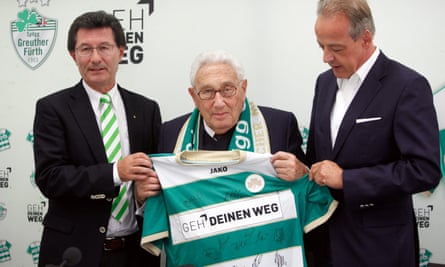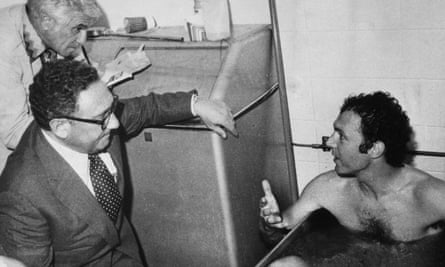Peru, Pelé and Grimsby: Henry Kissinger and his curious football links
IIt was the last match of the second group stage. Earlier in the day, Brazil had beaten Poland 3-1, meaning Argentina had to beat Peru by four to reach the 1978 World Cup final. Before kick-off, the Peruvian team was visited in their dressing room by Jorge Videla, the leader of the military junta that had seized power in Argentina in 1976, and Henry Kissinger, who had been US Secretary of State until the previous January. The Peruvian players found this very strange.
Kissinger, who died on Wednesday, loved football and often attended games. For example, in 1976, after flying to Britain to discuss the crisis in Rhodesia, he went to Blundell Park for Grimsby’s victory over Gillingham with the Foreign Secretary, Tony Crosland, a passionate Grimsby fan.
Eight months later, Crosland took him to watch Chelsea draw 3–3 with Wolves in the old Second Division. He had also visited the dressing room then, to widespread bewilderment.
“He said he loved football,” said Chelsea striker Steve Finnieston. “The players’ comments ranged from ‘Okay, mate?’ to ‘Who is that wanker?’ … There wasn’t a lot of respect shown.”
But what happened in Rosario was sinister. “It seemed like they were just there to greet and welcome us,” said Peruvian captain Héctor Chumpitaz. “They also said they hoped it would be a good match because there was a lot of expectation from the Argentinian crowd. He wished us luck, and that was it.
“We started looking at each other and wondering, shouldn’t they have gone to the Argentina room and not our room? What is happening? I mean, they wished us luck? Why? It left us wondering…’
Kissinger’s office said he had “no memory” of the incident.
Argentina eventually won 6-0, which raised eyebrows. There is a lot of circumstantial evidence for a solution: unproven allegations that the Argentine government has shipped 35,000 tons of grain and possibly some weapons to Peru, and that the central bank has released $50 million in frozen Peruvian assets.
Most disturbing were accusations made by a Peruvian senator, General Ledesma, to a judge in Buenos Aires in 2012 that the match had been rigged as part of Operation Condor, a grim plan that involved South American dictatorships torturing each other’s dissidents with Kissinger was involved. Videla accepts 13 prisoners from Peru in return.
“Were we pressured? Yes, we were put under pressure,” midfielder José Velásquez told Channel 4. “What kind of pressure? Government pressure. From the government to the managers of the team, from the managers of the team to the coaches.”
Maybe that’s true, but anyone looking at the game looking for an obvious solution will be disappointed. Peru hit the post in the first half and their goalkeeper, Ramón Quiroga, made a series of fine saves. When the eye is not looking for a solution, it seems that Peru, with nothing to play for, simply collapsed in the second half under the pressure of relentless Argentine attacks and a ferocious home crowd.
As for Kissinger’s presence, he was an ally of Videla – “If things have to be done, do them quickly,” he reportedly told him after the 1976 coup – and he loved football.
As a boy growing up in Bavaria, he had been a fan of his hometown club, Greuther Fürth, who were German champions three times between 1916 and 1929. When he became Richard Nixon’s national security adviser in 1969, the staff included reports on the team’s games in his Monday morning briefing papers.
after newsletter promotion

He also played football, first as a goalkeeper and then, after breaking a bone in one hand, as an inside forward. He invented new tactics that, according to the account he gave to Brian Kilmeade in The Games Do Count, were a precursor to catenaccio, although it sounds more like simply bringing players together behind the ball. “The system was to drive the other teams crazy by not letting them score, by keeping so many people back as defenders,” he said. “It’s very difficult to score when there are ten players in front of the goal.” It comes as no surprise that the end was more important to him than the means.
Although his family’s flight to the US to escape Nazi persecution took him away from football, Kissinger continued to find it a useful tool of diplomacy, especially with Leonid Brezhnev with whom he had a lengthy conversation about Garrincha at a summit in Moscow in 1973. When he saw football fields in spy plane photos in Cuba in 1969, he realized that Soviet troops were stationed on the island. “Cubans play baseball,” he snapped at Bob Haldeman, Nixon’s chief of staff. He helped João Havelange oust Stanley Rous as FIFA president in 1974 and arrange Pele’s move to the New York Cosmos a year later, both as part of a broader plan to improve US-Brazil relations.

However, Havelange fell out with Kissinger, apparently over the US’s doomed bid to host the 1986 World Cup, accusing him of fixing the second-leg match at the 1974 World Cup when the Netherlands defeated Brazil 2–0. By then, Kissinger’s reputation was such that wherever there were wheels within wheels, he could credibly be accused of spinning them.
And why, given that he was one of the first top figures to see the potential of world sport in politics, wouldn’t he translate it into football?
